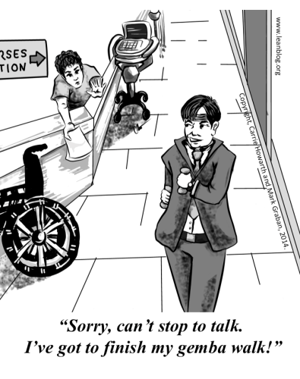 Because we get the opportunity to chat with organizations of all shapes and sizes about their continuous improvement efforts and processes, we have a unique point of view that gives us insight into what organizations are doing well, and what challenges they face. We see exciting signs of success and common stumbling blocks. Recently we were reminded about one classic leadership mistake, assuming that all managers know how to do a Gemba walk.
Because we get the opportunity to chat with organizations of all shapes and sizes about their continuous improvement efforts and processes, we have a unique point of view that gives us insight into what organizations are doing well, and what challenges they face. We see exciting signs of success and common stumbling blocks. Recently we were reminded about one classic leadership mistake, assuming that all managers know how to do a Gemba walk.
Management Skills Require Training and Reinforcement
People in most entry and mid-level management positions got there because they were excellent individual contributors who showed signs of leadership skills. Too often, however, they are never taught specific management techniques and tactics. Not wanting to sound incompetent, they rarely raise their hand and ask for this type of training. So what you end up with is a lot of talented, dedicated people who are essentially winging one of the most important functions in the company. When it comes to Gemba walks, they may know that the practice is expected and report dutifully that they are taking the walks, but often no one follows up to see how the walks are being executed.
Gemba Walks are a Skill
You wouldn’t assume that a worker knows how to use a particular piece of equipment or software. Nor would you set them to work on it without checking in to make sure they are using it properly. In the same way, it is important to teach new managers how to have an effective Gemba walk and to observe them doing so from time to time. For those who supervise managers, your Gemba is their Gemba.
What Could Go Wrong
Why is it so important to ensure that Gemba walks are properly performed? Because getting good results requires close adherence to the following principles:
- Gemba walks are about observing processes and workspaces, not individual performance assessment
- Gemba walks are opportunities for asking questions and getting firsthand information from the people who do the work
- Changes to processes are made only after the Gemba walk, following a period of reflection and usually the application of a PDSA or DMAIC cycle
If these principles are not followed, Gemba walks can be interpreted as punitive by employees. When this happens, communication screeches to a halt and people say what they think is expected, rather than reveal the actual facts on the ground.
Some managers will report doing Gemba walks, but they have the technique confused with huddle meetings, Management by Walking Around, or some other form of employee interaction.
If you haven’t observed your managers doing Gemba walks recently, we hope this post will persuade you to do so. It’s a skill like many others that requires training, coaching, and collaboration.
For more information about Gemba walks, check out this free eBook:


Add a Comment